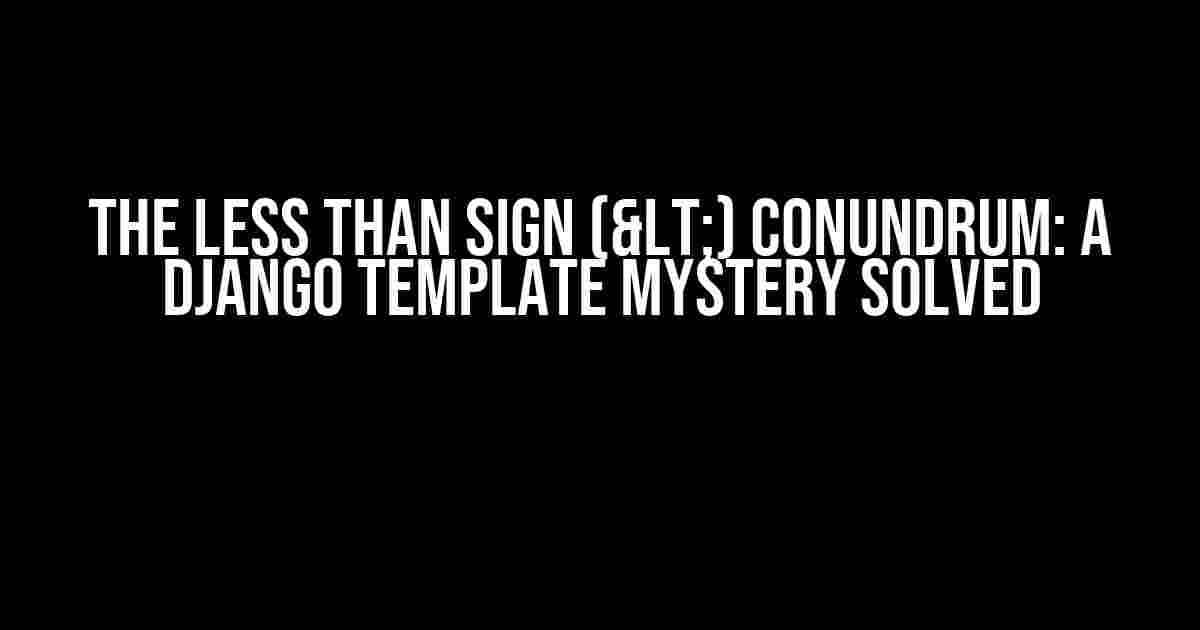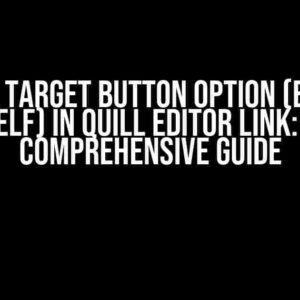Have you ever found yourself staring at a Django template, wondering why the less than sign (<) refuses to cooperate? You’re not alone! This pesky symbol has tripped up many a developer, leaving them scratching their heads and questioning their coding skills. Fear not, dear reader, for in this article, we’ll delve into the reasons behind this issue and provide you with the solutions you need to get back to coding triumphantly.
What’s the fuss about?
The less than sign (<) is a fundamental symbol in HTML, used to denote the start of an HTML tag. In Django templates, however, it’s a different story. When you try to use the less than sign in a Django template, it gets interpreted as an HTML tag, leading to unexpected results or, worse still, a TemplateSyntaxError.
Why does this happen?
The reason for this behavior lies in the way Django templates handle HTML characters. By default, Django templates automatically escape HTML characters to prevent XSS attacks and ensure security. This means that when you use the less than sign (<) in a template, Django treats it as an HTML tag and tries to parse it, resulting in errors or unexpected output.
Solutions to the Less Than Sign Conundrum
Don’t worry, we’ve got you covered! Here are a few ways to get the less than sign (<) working in your Django templates:
Method 1: Use the |safe Filter
The |safe filter is a built-in Django template filter that marks a string as safe, disabling HTML escaping. You can use it to render the less than sign (<) as a literal character.
{{ my_variable |safe }}
In the above example, if my_variable contains a string with a less than sign (<), the |safe filter will ensure it’s rendered correctly.
Method 2: Use the autoescape Tag
The autoescape tag is another way to control HTML escaping in Django templates. By setting autoescape to off, you can prevent Django from escaping HTML characters, allowing the less than sign (<) to be rendered as a literal character.
{% autoescape off %}
{{ my_variable }}
{% endautoescape %}
Note that using autoescape off can introduce security risks if you’re not careful, so use it judiciously and only when necessary.
Method 3: Use a Custom Template Filter
If you need more control over HTML escaping or want to avoid using the |safe filter, you can create a custom template filter to handle the less than sign (<).
# myapp/templatetags/my_filters.py
from django import template
register = template.Library()
@register.filter
def literal(value):
return value
# mytemplate.html
{% load my_filters %}
{{ my_variable | literal }}
In this example, we’ve created a custom filter called literal that simply returns the input value without modifying it. This allows us to render the less than sign (<) as a literal character.
When to Use Each Method
Now that we have three solutions, let’s explore when to use each one:
| Method | Use Case | Pros | Cons |
|---|---|---|---|
| |safe Filter | When you need to render a trusted string containing HTML characters. | Easy to use, built-in filter. | May introduce security risks if used with untrusted input. |
| autoescape Tag | When you need to disable HTML escaping for a specific block of code. | Gives you fine-grained control over HTML escaping. | Can introduce security risks if not used carefully. |
| Custom Template Filter | When you need more control over HTML escaping or want to avoid using the |safe filter. | Provides maximum flexibility and control. | Requires more code and setup. |
Conclusion
The less than sign (<) may seem like a minor obstacle, but it can cause significant headaches in Django templates. By understanding the reasons behind this behavior and using one of the methods outlined above, you’ll be well on your way to harnessing the full power of Django templates.
Remember to always prioritize security and use the solutions that best fit your use case. With a little creativity and patience, you’ll be crafting Django templates like a pro, and the less than sign (<) will become a triviality.
Additional Resources
If you’re hungry for more information on Django templates and HTML escaping, check out the following resources:
Now, go forth and conquer the world of Django templates!
Frequently Asked Question
Are you stuck with the less than sign (<) not working in your Django template? Don’t worry, we’ve got you covered!
Why does the less than sign (<) not work in my Django template?
The less than sign (<) is an HTML entity that gets interpreted as the start of an HTML tag in your Django template. To use it as a literal character, you need to escape it using the `{{ ‘` }}` syntax or replace it with its HTML entity `<`.
How can I escape the less than sign (<) in my Django template?
You can escape the less than sign (<) by surrounding it with the `{{ ‘` }}` syntax, like this: `{{ ‘<' }}`. This tells Django to render the character as a literal less than sign instead of an HTML tag.
Can I use the HTML entity `<` instead of escaping the less than sign?
Yes, you can use the HTML entity `<` as a replacement for the less than sign (<). This is a safer approach, as it avoids any potential conflicts with HTML tags. Simply use `<` wherever you need to display a less than sign in your template.
Will escaping the less than sign (<) affect the performance of my Django app?
No, escaping the less than sign (<) or using its HTML entity `<` will not have a significant impact on your Django app’s performance. These are basic syntax adjustments that won’t affect the underlying logic or rendering of your templates.
Are there any other special characters I need to escape in my Django template?
Yes, there are a few other special characters you may need to escape in your Django template, such as the greater than sign (>), ampersand (&), and single and double quotes (' and "). Be sure to use their corresponding HTML entities or escape them using the `{{ ‘` }}` syntax to avoid any rendering issues.


